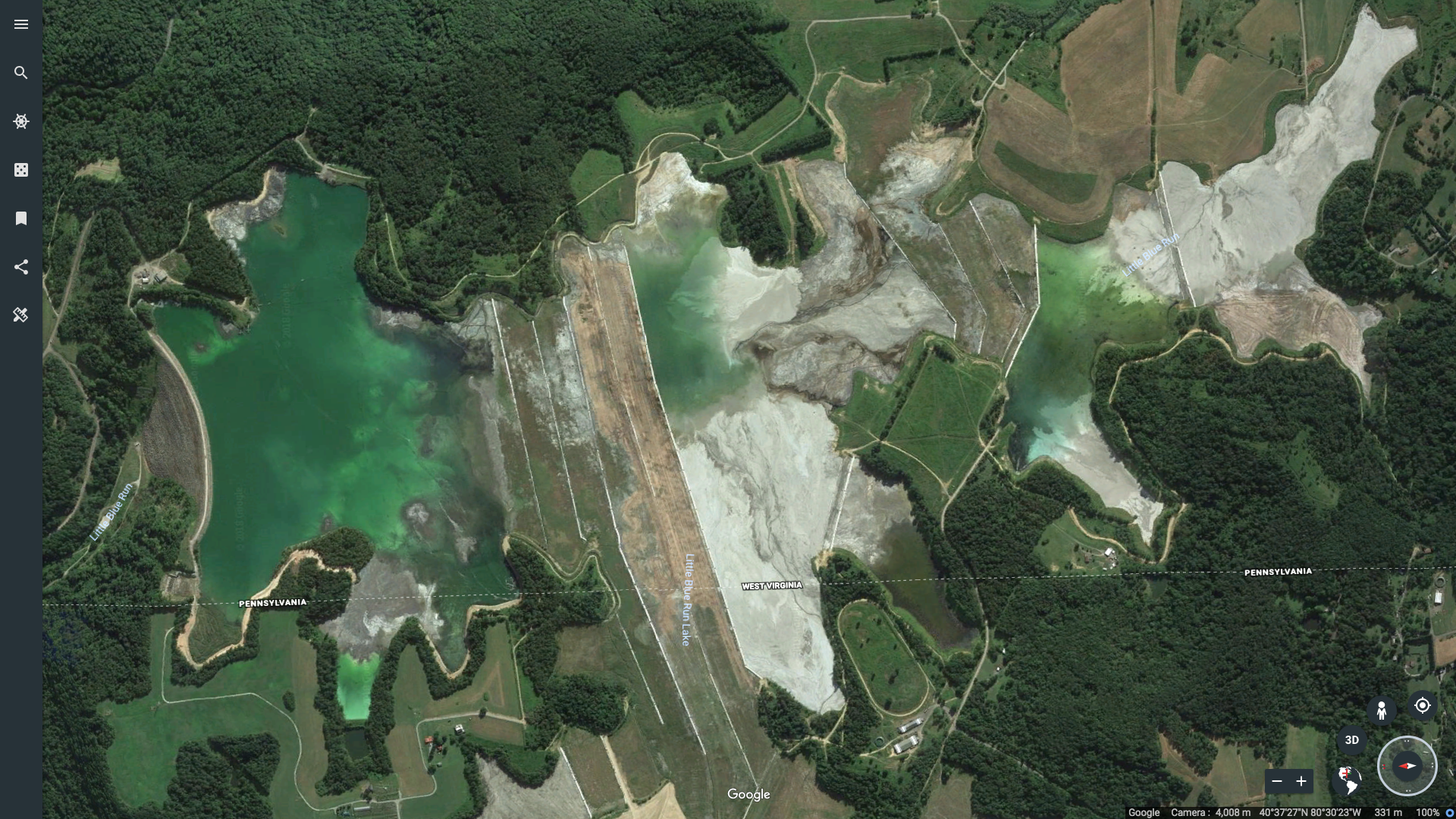
Little Blue Run coal ash pond, on the Pennsylvania-West Virginia border.
Google Earth


Little Blue Run coal ash pond, on the Pennsylvania-West Virginia border.
Google Earth

Google Earth
Little Blue Run coal ash pond, on the Pennsylvania-West Virginia border.
The largest coal ash pond east of the Mississippi is asking the state for a new pollution discharge permit. Little Blue Run, on the Pennsylvania – West Virginia border, has been closed for the past two years, but needs the permit because it’s still discharging toxic metals into nearby streams.
Little Blue Run was built in the 1970s and, unlike modern impoundments, it is unlined. That means it can leak contamination into the ground beneath it, which can seep out into nearby streams.
Because of these leaks, the Pennsylvania Department of Environmental Protection (DEP) ordered Little Blue Run’s owner, First Energy, to shut it down in 2012.
Since then, the company found 16 new seeps coming out of the site, said DEP spokeswoman Lauren Fraley. The proposed pollution discharge permit, which received a public hearing Wednesday night in Hookstown, will account for all of the potentially contaminated water coming out of these newly discovered sites.
Fraley said “about 150” of 400 sites tested near Little Blue Run were contaminated “from past waste disposal”. Coal ash contains naturally occurring but potentially toxic materials like mercury, cadmium and arsenic, according to the EPA.
Under the proposed permit, the company needs to monitor groundwater and seeps for arsenic, boron, selenium, and mercury. The main outfall at Little Blue Run is the Outfall 22, which discharges 3.5 million gallons a day into Mill Creek, a trout-stocked stream. Under the proposed permit, discharge from Outfall 22 would be re-routed into the main stem of the Ohio River.
Under the terms of the proposed permit, the company would not have to treat any of the discharge; environmental groups want the DEP to require the company to treat the water to remove contaminants.
Lisa Graves-Marcucci of the Environmental Integrity Project says the contamination coming off of Little Blue Run needs to be kept out of the area’s waterways.
“Coal ash is known to have a host of toxic metals and in particular arsenic and selenium and thallium. They’re all dangerous to people and the environment and water sources,” she said.
But Ryan Decker, an environmental engineer with the DEP’s Clean Water program said the Ohio River is big enough to dilute any pollution from the site to within federal clean water limits.
“If you’re discharging into a small stream, then there’s very little dilution available from the stream to mix with the discharge. If you discharge to a larger river, there’s a lot more dilution that would allow you to meet water quality standards,” Decker said.
Little Blue Run holds 118 million cubic yards of coal ash from the Bruce Mansfield power plant in nearby Shippingport.
In 2012 the DEP and FirstEnergy signed a Consent Decree ordering the company to stop sending coal ash to the impoundment by the end of 2016 and fining FirstEnergy $800,000.
In a separate complaint, the DEP said that because Little Blue is unlined, “contaminants from the solid waste within the impoundment” could “move into groundwater and surface waters near the site”. It also found calcium, sulfates, chlorides, and other contaminants from the impoundment were seeping into groundwater, and that arsenic found in groundwater may have originated from the coal ash.
Jennifer Young, a spokeswoman for FirstEnergy, said the company was currently capping the site with a liner and ‘several feet of soil’. She said that project is about a quarter done. She said once the impoundment is filled in, “we wouldn’t expect to see any outfall from the site any longer.” Final closure of Little Blue Run is expected in 2028.
StateImpact Pennsylvania is a collaboration among WITF, WHYY, and the Allegheny Front. Reporters Reid Frazier, Rachel McDevitt and Susan Phillips cover the commonwealth’s energy economy. Read their reports on this site, and hear them on public radio stations across Pennsylvania.
(listed by story count)
StateImpact Pennsylvania is a collaboration among WITF, WHYY, and the Allegheny Front. Reporters Reid Frazier, Rachel McDevitt and Susan Phillips cover the commonwealth’s energy economy. Read their reports on this site, and hear them on public radio stations across Pennsylvania.
Climate Solutions, a collaboration of news organizations, educational institutions and a theater company, uses engagement, education and storytelling to help central Pennsylvanians toward climate change literacy, resilience and adaptation. Our work will amplify how people are finding solutions to the challenges presented by a warming world.